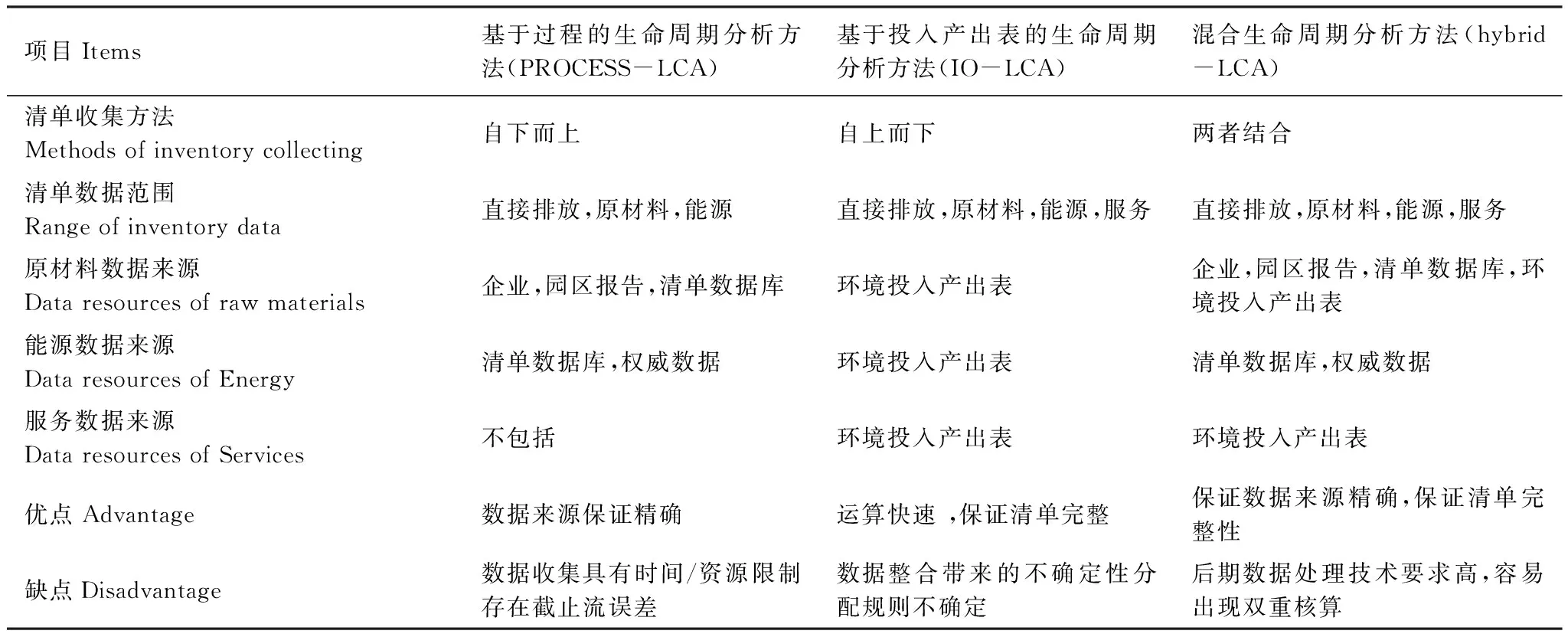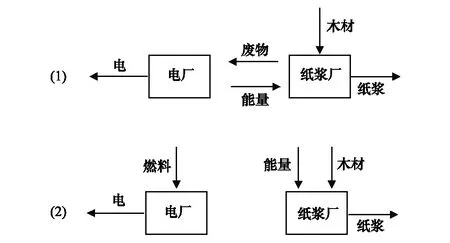生命周期方法在产业共生系统环境效益评价中的应用
——研究进展及问题分析
刘晶茹,严玉廷,聶鑫蕊,严 丽
中国科学院生态环境研究中心城市与区域国家重点实验室,北京 100085
生命周期方法在产业共生系统环境效益评价中的应用
——研究进展及问题分析
刘晶茹*,严玉廷,聶鑫蕊,严 丽
中国科学院生态环境研究中心城市与区域国家重点实验室,北京 100085
近年来,产业共生作为产业生态学最具特征的领域引起了相关研究者的广泛关注。当前的研究逐渐从产业共生系统的定性描述分析转向定量的系统评价上。传统的产业共生系统环境效益评价仅仅关注共生系统本身,而忽视了占环境影响20%—50%的上、下游过程及替代过程的环境影响,为了得到客观的、系统的环境影响评价,将生命周期分析方法引入产业共生效益评价显得尤为重要。首先回顾了生命周期分析方法在产业共生研究中的发展过程,接着评述了3种生命周期分析方法在产业生态研究中的优劣势。并重点分析了将生命周期思想引入产业共生效益评价方法存在的功能单位设定问题及系统边界的选择问题。最后,呼吁为避免隐形污染的转移,必须尽快将生命周期分析的方法和管理理念引入我国生态工业园设计、规划、评价和管理的全过程中。
产业共生;生命周期分析;替代效益
近年来,产业共生作为产业生态学最具特征的领域引起了相关研究者的广泛关注。产业共生这一术语最早出现于1947 年的经济地理文献,用以描述不同企业之间存在的“有机关系”[1- 2]。Marian Chertow 2000年将产业共生定义为:将传统分散的企业通过物质、能量、水或副产品的交换而产生的一种集群竞争优势,产业共生的核心是一种地理临近性所产生的一种合作和协同效应[3]。在“开展物质、能量、水和副产品交换”这一理念指导下,以区域内废弃物与副产品的充分利用为宗旨,各国相继开展了以生态工业园为主要形式的产业共生实践,通过文献梳理可以发现,产业共生的理论研究相对滞后于实践的发展。2000年以前,相关文献主要集中在对共生网络的“定性描述”上,而对产业共生关系如何减少环境影响的定量研究相对较少[4- 5]。近年来,国内外学者围绕着产业共生系统的生态效率评价[6- 7]、可持续性评价[8- 9]、柔性评价[10]和系统效率评价[11- 12]等方面进行了多种探讨,物质流分析方法、能值分析方法、能源系统分析方法、指标体系法成为主要研究方法。虽然侧重点不同,但相关研究均将产业共生系统作为一个“黑箱”,将“相互利用副产品或废弃物”的企业集合体作为研究对象,关注这个共生系统中由于副产品和废弃物的利用而带来的废弃物直接减排量及资源替代量,而来自于共生系统上游及下游的环境影响基本被排除在外。
1 基于生命周期方法的产业共生环境效益评价研究进展
2010年Shi等[13]评价了天津泰达经济技术开发区中主要共生链的环境效益,指出,从一个较长时间的视角看,必须将那些由共生关系所产生的超过园区边界的外溢效果考虑进来。同年,Sokka等[14]在评价芬兰林业产业共生系统的环境影响时,也考虑了系统“上游”的影响,他们的研究发现,共生系统上游过程的环境影响对于整个产业系统的贡献最大,仅仅关注共生系统本身的环境效益,会带来共生系统本身的环境影响减小、而更多的环境影响向系统外供应链转移的风险[15]。在这种背景下,生命周期分析方法作为一种系统评估方法而被引入产业共生环境效益评价的研究中。该方法可以通过考虑完整的能源和物质供应链来评价全方面的资源利用及服务所产生的环境影响[16],从而避免了环境影响问题在不同生命周期阶段、不同区域和不同环境标准语境下的转变[17]。
目前应用生命周期分析方法来评价产业共生系统的案例十分有限,根据评价目标,可以将其分为二类:第一类是对现有共生系统的评价,如Liu等[18]在2011年应用生命周期方法对金桥生态工业园的能源共生系统进行了环境影响评价,Dong 等[19]应用混合生命周期方法核算了沈阳高新区的碳足迹。第二类是对现有产业共生系统的改造设计,即利用生命周期过程分析,辅助其他系统优化方法,识别共生系统更多的潜在共生关系。如2007年Singh等[20]以提高共生系统全生命周期过程碳的转化效率为目标,对一个包含了甲酸、甲基胺等13个化工生产过程的产业系统进行了共生设计,提出了改进现有产业系统的优化方案。2009年Sokka等[21]对一个包含造纸厂、电厂和化工厂的芬兰林业共生系统开展了生命周期分析,着重分析了电厂余热利用、林业废弃物发电等能源共生关系所带来的直接及间接温室气体减排量。2010年,Sokka[14]等人对芬兰林业共生系统开展了更深入的研究,提出了构建更多共生关系的可能性,并核算了这些潜在的共生关系对减少系统生命周期环境影响的效果。同年,Hashimoto等[22]利用生命周期分析方法,为川崎生态城以水泥生产为中心的产业共生系统设计了3种减碳共生方案。
在前人探讨性研究的基础上,2012年Mattila[15]等人第一次系统的提出了生命周期分析方法在产业共生环境效益评价中的技术框架及应用范围等问题,他们认为生命周期分析方法在选择不同共生方案时是十分重要的工具,只有基于生命周期视角的决策才能够保证在建立产业共生关系时不会忽视更重要的间接环境影响问题。在开展新的生态产业园规划设计时有必要进行一个全面的生命周期分析,客观、系统的评估各种方案的潜在优劣势,从而为系统长期的可持续发展提供最佳的设计选择[23]。
2 产业共生系统的生命周期分析方法
生命周期分析方法是针对产品系统而发展起来的一种系统分析方法,随着生命周期方法在研究领域和研究视角的拓展及适用于中观及宏观层次的混合生命周期分析方法(hybrid-LCA)的提出,为该方法应用于产业共生系统提供了可能性。混合生命周期方法由Suh等人[24]在2004提出,是以过程生命周期方法(Process-LCA)为基础、以投入产出生命周期方法(IO-LCA)做相关截止流(上游、服务、替代)的一种新方法。2009年Lenzen和Wiedman[25]指出,应用混合生命周期分析方法的最佳路径是先用投入产出生命周期方法做一个快速的分析,然后采用结构路径分析方法从中选择最重要的污染物转移路径,再用过程生命周期方法进行详细分析。2010年Mattila等[26]以芬兰林业共生系统为例,分别用过程生命周期方法、投入产出生命周期方法和混合生命周期方法对其环境效益开展了评价,由于3种方法在收集清单数据时,对 “截止流(cutoff)”的考虑不同,即系统边界不同,因此3种方法所得到的各种环境影响结果会有不同程度上的差异。他们的研究结论是:投入产出生命周期方法跟混合生命周期方法结果更接近,因此可以作为量化产业共生系统环境影响的首选方法。他们同时对3种方法所需要的数据、数据来源及方法的优缺点进行了系统的比较(表1),这是目前唯一一个将3种方法同时应用与一个共生系统的研究案例。

表1 应用于产业共生系统的3种生命周期方法
3 开展产业共生系统生命周期分析的关键问题
虽然生命周期分析方法在产业共生系统系评价中的应用意义非常明显,但在实际操作中,依然面临着很大的困难。因为传统的生命周期分析方法是针对单个产品系统而建立的,这里的“产品系统”要相对独立,从而其系统的输入输出会比较明确,便于数据获取。而产业共生系统强调的是子系统之间存在的“共生关系”,因此,将传统应用于单个产品系统的生命周期分析方法引入产业共生研究中仍然存在一定的挑战,包括数据的选取、系统边界的设定、技术参数的选择等,其中最主要的两个问题是功能单位及参照系统的设定问题,这是开展共生系统评价的前提。
3.1 功能单位设定问题
功能单位是生命周期分析中作为参照单位的产品系统性能,它的基本作用就是为有关的输入和输出提供参照基准。产业共生系统是一类经济体,其主要功能仍然是提供以产品为主要形式的经济产出。因此,从目前的研究案例看,功能单位主要是产业共生系统一年经济活动所产生的经济量(货币为单位)及产品量(重量为单位,product mix)[14]。选择经济量作为功能单位,便于建立产业共生系统与经济投入产出数据之间“关联”,使得生命周期分析的“中游”与使用投入产出分析方法的“上”、“下”游单位一致。但该方法不能体现“产业共生”系统生产结构与生产技术的特殊性,因为投入产出方法本身是建立在假设系统内部同一产业部门“技术均衡”的前提下的。当选择物质量作为评价单位时,共生系统“当地(on-site)”的环境影响可以用“至下而上”的过程生命周期分析方法进行核算,该方法的优点是所有参数均来自共生系统,从而能够客观的反应共生系统的产业结构及生产技术水平。但该方法存在两个不确定性,一是所有产品产出需要转换为货币量后才能与投入产出表建立“关联”,二是过程生命周期分析方法与投入产出生命周期分析方法的系统边界不同,两个方法所获取的数据在进行对比时,会存在口径的不一致问题,从而影响了数据的可比性。
3.2 参考系统的设定问题

图1 产业共生系统(1)和假设的参考系统(2)[26]Fig.1 Industrial symbiosis (1) and hypothetical reference (2)[26]
开展产业共生系统评价的根本目的是对比分析“共生”与“不共生”情况下两个系统的环境影响,因此,设定一个与共生系统具有可比性的参照系统(reference system)是十分必要的。设定参照系统时最关键的问题是系统边界的确定,图1所示的是一种最简单的包含两个过程的共生系统,其中(1)为共生系统,(2)为参照系统,两个系统具有相同的产出(电和纸浆),具有可比性。在对系统开展生命周期分析时,共生系统(1)中产出的“电和纸浆”的生产原料和生产技术来自共生系统,参照系统(2)的产出“电和纸浆”反映的是国家生产电力和纸浆的平均水平。通过对比,可知共生系统生产单位电力和纸浆所产生的环境影响与国家平均生产水平的区别,这个“区别”既可认为是“共生”效益。
但这是一个最简单的过程,被Mattila[15]称为归因法(attribution),即假设这个共生系统在当前或是短期内不会对国家尺度的产业系统结构产生影响,因此,可以直接利用现有的投入产出表核算“截止流”。当评价一个城市尺度或国家层次的共生系统时,上面的假设是不成立的。此时需采用结果法(consequence),这种方法考虑了共生系统长期的影响结果,认为共生系统所发生的替代过程会通过市场和技术的作用而逐步改变整个国家的经济结构[27],此时开展生命周期分析所设定的系统边界就是与投入产出表相关的整个经济系统,而不仅仅是产业共生系统,并需要辅助反推法等系统分析工具来进行替代效应的评价。
4 评述与展望
生命周期方法正在朝着一个多视角、多主体、多维度的系统整合方向发展,已逐渐发展成为一种中、宏观决策支持的“可持续”(SLCA)的系统评价方法[28]。生命周期分析是对产业共生系统进行全方位“溯踪”的过程,既包含产业共生系统本身,又包括为产业共生系统运行提供支撑和服务的上游及下游过程。由于生命周期方法本身所具有的全过程性、客观性和系统性,使其必将成为产业共生系统设计、规划和评价的重要工具之一,但如何将这一针对产品系统而开发的工具应用于复杂的产业生态系统是该方法面临的挑战之一。
生态工业园的研究和实践在国内蓬勃发展,但我国的产业共生系统在设计、规划和评价时,均停留在强调控制园区内直接污染排放的层次,这会导致生态工业园将间接的污染过程向园区外转移的风险。为客观的评价我国生态工业园的建设成果,我们认为必须尽快引入生命周期分析的方法和管理理念,将生命周期分析、生命周期评价、生命周期设计与生命周期管理贯穿在生态工业园设计、规划、评价和管理的全过程中。
2010年国际生命周期参考数据系统(ILCD)在其发布的生命周期技术指导手册中为该方法如何应用于中观和宏观层次的决策支持提供了指导准则,这为产业共生系统的生命周期分析提供了一个通用的研究框架[29]。经过十几年的发展,我国学者在生命周期分析方法、典型产品分析、生命周期清单数据库等方面取得了长足进展[30],为国内开展产业系统生命周期分析提供了良好的数据基础。随着生命周期分析方法的发展,必将成为产业共生系统设计、评价和管理的基本方法和系统框架。
[1] Frosch R. The Industrial Ecology of the 21st century. New York: Scientific American, 1995: 178- 181.
[2] 石磊, 刘果果, 郭思平. 中国产业共生发展模式的国际比较及对策. 生态学报, 2012, 32(12): 3950- 3957.
[3] Chertow M R. Industrial symbiosis: Literature and taxonomy. Annual Review of Energy and the Environment, 2000, 25(1): 313- 337.
[4] Lambert A J D, Boons. Eco-industrial parks: stimulating sustainable development in mixed industrial parks. Technovation, 2002, 22(8): 471- 484.
[5] Boons F, Spekkink W, Mouzakitis Y. The dynamics of industrial symbiosis: a proposal for a conceptual framework based upon a comprehensive literature review. Journal of Cleaner Production, 2011, 19(9/10): 905- 911.
[6] 商华, 武春友. 基于生态效率的生态工业园评价方法研究. 大连理工大学学报: 社会科学版, 2012, 28(2): 25- 29.
[7] Bai L, Qiao Q, Yao Y, Guo J, Xie M H. Insights on the development progress of National Demonstration eco-industrial parks in China. Journal of Cleaner Production, 2014, 70: 4- 14.
[8] 元炯亮. 生态工业园区评价指标体系研究. 环境保护, 2003, (3): 38- 40.
[9] 黄方, 卓问, 刘余. 工业生态园综合评价模型的建立. 四川环境, 2007, 26(1): 55- 58, 76- 76.
[10] 王艳丽, 周美华. 生态工业园柔性模型的建立及评价. 东华大学学报: 自然科学版, 2006, 32(6): 47- 50.
[11] 邓伟根, 陈林. 投入产出表在生态工业园中的应用. 东北财经大学学报, 2007, (2): 58- 60.
[12] 孙晓梅, 崔兆杰, 朱丽, 刘雷. 生态工业园运行效率评价指标体系的研究. 中国人口·资源与环境, 2010, 20(1): 124- 128.
[13] Shi H, Chertow M, Song Y Y. Developing country experience with eco-industrial parks: a case study of the Tianjin Economic-Technological Development Area in China. Journal of Cleaner Production, 2010, 18(3): 191- 199.
[14] Sokka L, Lehtoranta S, Nissinen A, Melanen M. Analyzing the environmental benefits of industrial symbiosis. Journal of Industrial Ecology, 2010, 15(1): 137- 155.
[15] Mattila T, Lehtoranta S, Sokka L, Melanen M, Nissinen A. Methodological aspects of applying life cycle assessment to industrial symbioses. Journal of Industrial Ecology, 2012, 16(1): 51- 60.
[16] Baumann H, Tillman A -M. The Hitch Hiker′s Guide to LCA: An Orientation in Life Cycle Assessment Methodology and Applications. Lund, Sweden: Studentlitteratur AB, 2004.
[17] Finnveden G, Hauschild M Z, Ekvall T, Guinée J, Heijungs R, Hellweg S, Koehler A, Pennington D, Suh S. Recent developments in life cycle assessment. Journal of Environmental Management, 2009, 91(1): 1- 21.
[18] Liu Q, Jiang P P, Zhao J, Zhang B, Bian H D, Qian G R. Life cycle assessment of an industrial symbiosis based on energy recovery from dried sludge and used oil. Journal of Cleaner Production, 2011, 19(15): 1700- 1708.
[19] Dong H J, Geng Y, Xi F M, Fujita T. Carbon footprint evaluation at industrial park level: A hybrid life cycle assessment approach. Energy Policy, 2013, 57: 298- 307.
[20] Singh A, Lou H H, Yaws C L, Hopper J R, Pike R W. Environmental impact assessment of different design schemes of an industrial ecosystem. Resources, Conservation and Recycling, 2007, 51(2): 294- 313.
[21] Sokka L, Pakarinen S, Melanen M. Industrial symbiosis contributing to more sustainable energy use-an example from the forest industry in Kymenlaakso, Finland. Journal of Cleaner Production, 2011, 19(4): 285- 293.
[22] Hashimoto S, Fujita T, Geng Y, Nagasawa E. Realizing CO2emission reduction through industrial symbiosis: A cement production case study for Kawasaki. Resources, Conservation and Recycling, 2010, 54(10): 704- 710.
[23] Lim S R, Park J M. Interfactory and intrafactory water network system to remodel a conventional industrial park to a green eco-industrial park. Industrial & Engineering Chemistry Research, 2009, 49(3): 1351- 1358.
[24] Suh S, Huppes G. Methods for life cycle inventory of a product. Journal of Cleaner Production, 2005, 13(7): 687- 697.
[25] Wiedmann T O, Lenzen M, Barrett J R. Companies on the scale. Journal of Industrial Ecology, 2009, 13(3): 361- 383.
[26] Mattila T J, Pakarinen S, Sokka L. Quantifying the total environmental impacts of an industrial symbiosis-a comparison of process-, hybrid and input-output life cycle assessment. Environmental Science & Technology, 2010, 44(11): 4309- 4314.
[27] Ekvall T, Assefa G, Björklund A, Eriksson O, Finnveden G. What life-cycle assessment does and does not do in assessments of waste management. Waste Management, 2007, 27(8): 989- 996.
[28] Curran M A. Life Cycle Assessment Handbook: A Guide for Environmentally Sustainable Products. Hoboken, NJ, USA: Wiley, 2012.
[29] ILCD (International Reference Life Cycle Data System). General Guide for Life Cycle Assessment-Detailed Guidance. Ispra, Italy: Joint Research Centre: Institute for Environment and Sustainability, 2010.
[30] Nie Z R. Development and application of life cycle assessment in China over the last decade. International Journal of Life Cycle Assessment, 2013, 18(8): 1435- 1439.
The application of life cycle assessments to the evaluation of the environmental benefits of industrial symbioses: research progress and challenges
LIU Jingru*,YAN Yuting, NIE Xinrui, YAN Li
ResearchCenterforEco-EnvironmentalSciences,ChineseAcademyofSciences,Beijing100085,China
As one of the most popular areas of research in industrial ecology, industrial symbiosis has received a great deal of attention from researchers in recent years. Environmental benefits, including efficient resource recycling and waste utilization, are the primary factors that distinguish industrial symbiosis from other economic systems, and are considered the objectives of achieving the successful development of ecological industries. Thus, research has gradually shifted from the qualitative description of industrial symbiosis to its quantitative and systematic evaluation, which incorporates material flow analyses, energy analyses, and the structuring of index systems. However, there are several drawbacks to these traditional methods: 1) the symbiosis is treated as “black box”, which ignores the mutual effects of internal processes, and 2) these methods usually focus on the system itself, but neglect upstream, downstream, and replacement processes that account for 20% to 50% of the overall environmental impact. This increases the risk of producing emissions that are then transferred to supply chains outside of the system under examination. In order to avoid the problem of environmental impact transferred in different life cycle stages, life cycle assessment (LCA) is introduced to the field in benefits evaluation of industrial symbiosis to gain more objective and systematic results of environmental impact assessment. In light of this, this paper first reviews the process of developing life cycle assessments intended for use in the study of industrial symbiosis. These can take two different approaches: the evaluation of existing industrial symbioses in order to facilitate the identification of potential symbiotic relationships that could be developed further, and the outright planning and design of industrial symbiosis systems, in order to optimize plans and ensure that they are environmentally friendly prior to construction. In these different case studies, life cycle assessments have proven vital to the analysis of the benefits of symbiosis. In this paper, previous reviews are used to analyze and compare the three established methods of life cycle analysis: process-LCA, IO-LCA, and hybrid-LCA. These strategies primarily differ with respect to methods, range, and the data resources available for inventory collection. Nevertheless, when introduced to the study of industrial symbiosis, certain key issues with applying traditional life cycle assessments to a single product system remain unresolved: 1) set of functional unit:there are two choices of function unit, one is economic quantity (currency) produced by the symbiosis system within a year, the other is product quantity-the product mix (weight) produced by the symbiosis system within a year and 2) the selection of system boundaries: when studying symbiotic relationships, a hypothetical reference system should be used, within which the subsystem is mutually independent. The selection of system boundaries should ensure that the two systems under comparison produce the same output; there are two methods of achieving this, attributional process nad consequencial process, which depends on the scale of the research being conducted. Finally, to conduct a more objective evaluation of the benefits of developing industrial symbioses in our country, we propose that the concepts of life cycle assessment and management should be incorporated into the entirety of the planning process, evaluation, and management of ecological industrial parks.
industrial symbiosis; life cycle assessment; alternative benefits
国家自然科学基金面上资助项目(71173209);国家自然科学基金重点资助项目(71033005)
2014- 11- 03;
2016- 03- 08
10.5846/stxb201411032156
*通讯作者Corresponding author.E-mail: liujingru@rcees.ac.cn
刘晶茹,严玉廷,聶鑫蕊,严丽.生命周期方法在产业共生系统环境效益评价中的应用——研究进展及问题分析.生态学报,2016,36(22):7202- 7207.
Liu J R,Yan Y T, Nie X R, Yan L.The application of life cycle assessments to the evaluation of the environmental benefits of industrial symbioses: research progress and challenges .Acta Ecologica Sinica,2016,36(22):7202- 7207.

